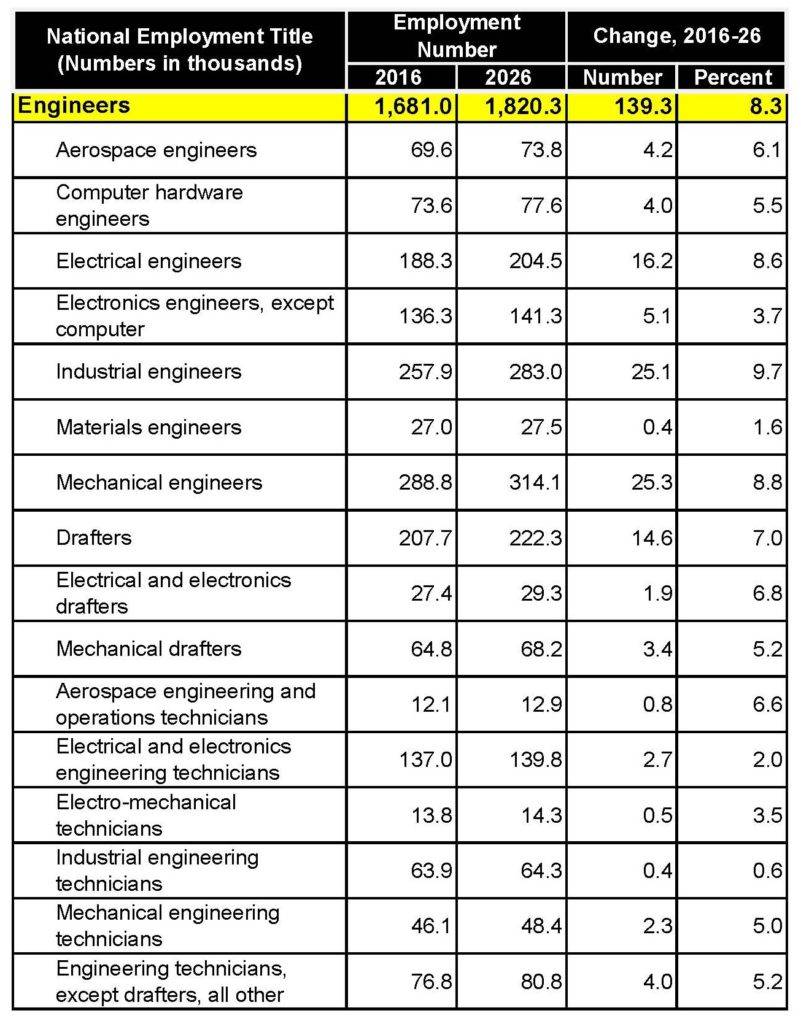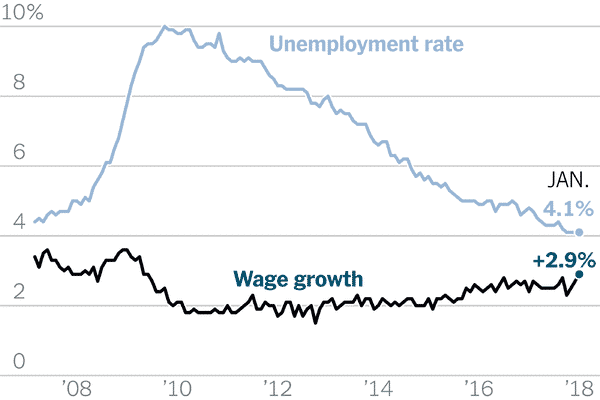As 2018 closes with one of the highest growth in labor participation, we look towards the possible employments trends that are coming in 2019, particularly those that will affect the job prospects of engineering talents:
1. Engineering hiring projected to grow up to 2026
On October 2017, the Bureau of Labor Statistics (BLS) released its 10-year employment projections based on their findings on 2016’s workforce participation. The good news is: national employment is projected to increase by 11.5 million within the decade. When BLS broke it down by occupation titles, it stated that engineering positions (including mechanical engineers, drafters and R&D technicians) are projected to grow by 8.3%. What this tells us is that hiring for these engineering talents is not slowing down any time soon:
(Engineering growth 2016-2026 from BLS.gov’s Table 1.7 of Occupational Projections)
2. Salaries projected to grow by 3.2% (a meager .10% increase from 2018)
In 2018, salaries increased by 3 percent — a 9-year high since the recession. Though it had been a strong labor market, economists predict that wage growth will remain at that rate or increase slightly in 2019.
(Image Credit: New York Times)
Salary increase was a sign that more companies are trying to stay competitive in terms of recruiting and retaining top talent; however, according to the Society for Human Resource Management, companies are now exploring holistic compensation packages to attract workers rather than continuing to increase wages. This may include a better performance-based reward structure or individually-tailored advancement opportunities.
Despite the enactment of the Tax Cuts and Jobs Act of 2017 (TCAJA) where corporate taxes were lessened BY 14%, its impact on workers’ wages is very minimal. Among the 1,500 businesses that HR Consulting Firm Mercer surveyed, 68% said they are not planning to redirect tax savings towards salary budget increase.
“Expectations for growth in U.S. salary budget increases have been mounting for many months,” said Alison Avalos, research director at WorldatWork, an association of total rewards professionals. “However, despite significant tax-reform changes and a tight labor market, the one-tenth of a percentage point movement isn’t the growth that was anticipated. This year’s survey data gives us little reason to think that U.S. organizations intend to significantly invest more dollars into salary increases for 2019.”
3% is the current national average in wage growth, but in cities with higher costs of living, wage rate is expected to go higher in 2019. According to Human Capital Analysts AON, cities like San Francisco and Los Angeles are expected to have a higher wage increase at 4% and 3.7%.
3. Digital offices will be on the rise – More employers will be offering work-from-home opportunities
Due to the tight labor market, employers are trying to get ahead of the competition for top talent by offering creative benefits that are more favorable for their employees’ work-life balance. Ranking high among those benefits is the option to work from home or telecommute.
In Dice.com’s 2018 salary report, 60% of the tech workers surveyed said they would prefer to work at a job where they can work remotely half the time or more, and 63% said they would be willing to take a pay cut to telecommute at least half the time.
Workforce analysts often point to Dell, a multinational computer technology corporation, as an example of the mutual benefits of telecommuting for employees and employers. The primary reason for this is the $12 million a year in total real estate savings for Dell, as well as the savings of roughly $350 a month in commute costs for the employees. In 2016, 25% of Dell’s US-based employees have the option to work from home. They are expecting to raise that to 50% by 2020.
4. Companies will be hiring more contract workers
In a recent CNBC article, it was revealed that Google’s contingent workforce has outnumbered their full-time employees for the first time in its 20-year existence. The contingent workers include temporary workers, vendors and contractors (more commonly identified in Google as TVCs). Most of them are working in “white-collared” roles such as customer service, engineering and even in executive management. With this revelation, thousands of TVCs have penned a letter to Google’s CEO, Sundar Pichai, in the first week of December asking for equal pay and benefits (such as medical insurance and paid vacation) as its full-time employees. These current events may cause a chain reaction to the contingent workforce labor laws so the spotlight is currently on Google.
Prior to these events taking place, it has been predicted by the World Economic Forum in its “Future Of Jobs” report that 50% out of the 313 global companies that they surveyed expect that automation will lead to some reduction in their full-time workforce by 2022. In addition, businesses are set to expand their use of contract workers and will be hiring more on project-based or temporary capacity to have better flexibility in labor market transformations.
The movement for contractual hiring is also driven by more and more workers opting for freelance assignments over permanent employment. According to American Staffing Association (ASA), there are three million contract employees working for America’s staffing companies during an average week. 1 in 5 workers cite that they choose to work on a contractual basis due to its flexible nature.
As the go-to resource for the engineering community, SoloPoint Solutions aims to provide our clients with updates on recent industry news and trends that may affect the engineering workforce landscape. For more information regarding our services, please call us at (408)246-5945 or (714)708-3639.



